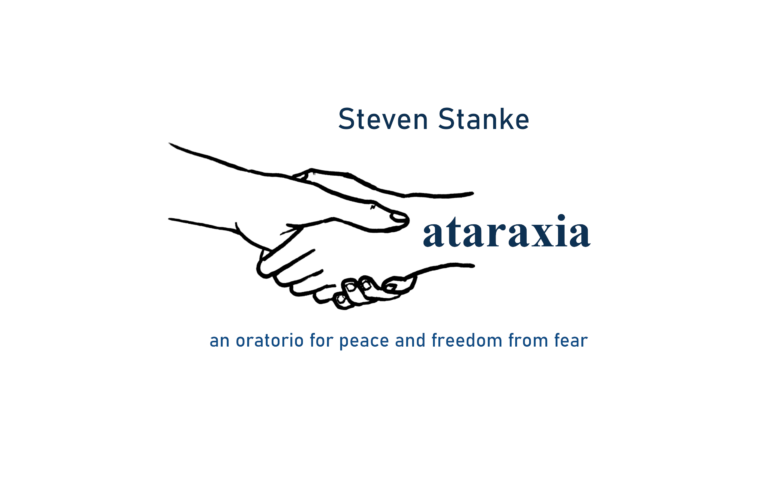
for narrator, soloists (SATB), chorus (SATB) and orchestra
3[1.2.pic] 3[1.2.ca] 3[1.2.bcl] 3[1.2.cbn] – 4 3 3 1 – tmp+4 – pno – str
perc: sd, tmpl blcks, bd, tam-tam, sus cym. cym,tri, tom, xylo, glock, chimes
DURATION Part One 22 mins, Part Two 17 mins, Part Three 13 mins, The Call 6 mins TOTAL 58 mins
00:00 CHORUS The Abyss (Part 1)
4:49 SOLO BASS Resentment
22:19 CHORUS AND SOLOISTS The Battle
38:31 CHORUS AND NARRATOR Amsterdam Declaration 2022
PROGRAM NOTES
ataraxia: an oratorio for peace and freedom from fear was written as a response to an ever more noticable division between those who embrace humanity, diversity and empathy, and those who display suspicion, rejection and isolation. In real life, online, distant, and close, these divisions have become increasingly obvious, and are often used for political or social purposes. When I read an article by Tom Nichols in The Atlantic called Lost Boys: The Violent Narcissism of Angry Young Men, I knew I had the impetus for the formulation of a response in the form of a major choral work. Nichols lists the traits common to many young men who commit mass murder – insecurity, arrogance, rage, resentment, hatred, isolation and of course, narcissism. These traits are, indeed, not limited to these “Lost Boys” but are noticeable and baffling to those who are able to choose a more empathetic life view. Verbal and textural examples of these traits are commonplace, particularly on social media, where voices are often unmoderated, influenced and inflamed by anonymity. A line may be drawn from excessive instances of these traits to solo and community atrocities including national oppressions, invasions and genocides.
Sage advice for life, based on understanding, respect and empathy, may be found in works such as the Amsterdam Declaration issued by Humanists International, most recently in 2022. This statement in particular lists the fundamental principles of a “democratic and ethical life stance, which affirms that human beings have the right and responsibility to give meaning and shape to their own lives.” These principles, which, if practised, support human rights, scientific thinking and artistic creativity, and offer ethical and rational means of addressing the challenges of our time. This statement, in my mind, stands in stark contrast to the unremitting stance of many loud conservative voices.
In designing a large choral work, I turned to Handel’s Messiah and Tippett’s A Child of our Time, which provided the tripartite formal design. Merion Bowen, in Music of the Angels: Essays and Sketchbooks of Michael Tippett, reports that, in The Messiah, Tippett observes, accurately, that the “first part is all prophecy and preparation. The second part is epic: from the birth of Christ to the second coming, judgement, millennium, and world’s end. The third part is meditative.” A Child of our Time, Part I, Tippett explains, “deals with the general state of oppression in our time; Part II presents the particular story of a young man’s attempt to seek justice by violence and the catastrophic consequences; while Part III considers the moral to be drawn, if any.” This broad three-part formal outline of the general, the particular and the moral became the structure on which I placed the text of ataraxia: an oratorio for peace and freedom from fear.
Nichols’ list of traits provided a starting point for Part I, with the final selections including resentment, boredom, anger, insecurity, hate and selfishness. Authors ranged in date from Seneca to Walt Whitman, providing some proof to the universality and timelessness of the topics. Mary Darby Robinson’s lengthy Ode to Envy, with capitalised references to malice, ignorance, jealousy, and ambition, provided the perfect accompaniment for the chorus as they add a more complete picture of malevolence. A sinewy, brooding theme, first heard by the cellos in the opening movement, provided musical material for the personification of evil, against a continuous drone, representing stability and timelessness and expanding chords from the orchestra and choir, depicting change and growth.
The battle movement opens with the first two verses of Julia Ward Howe’s Battle Hymn of the Republic. This is representative of a group using religion as their crux, relying on the presumed presence of an unseen and unknown force as sustenance and power. In contrast to this is Percy Shelley’s “old, mad, blind, despised, and dying King,” and “a people starved and stabbed” (England in 1819), depicting current idolised leaders and polarities. The movement descends into chaos using anonymous texts taken from social media, where arguments are commonplace, reason and respect scarce, and changes of opinion rare.
The work ends with a reading of the Amsterdam Declaration 2022 and a setting of Henry Wadsworth Longfellow’s The Builders. Although possibly overoptimistic, these works, in my mind, epitomise the simplicity that is the human being and our continuation as social creatures and residents of this planet. Longfellow states that all people, no matter who they are or when they have lived, have and will contribute to our shared history. No one’s actions or deeds are useless, valueless or go unnoticed. All should focus on the structures that they are building and the legacy that they will leave. The Amsterdam Declaration promotes ethics, rationalism, personal liberty combined with social responsibility, and a reliable knowledge of the world based on observation, evaluation and revision. Friedrich Nietzche’s call to knowledge and wisdom, concludes the work.
Steven Stanke
2024